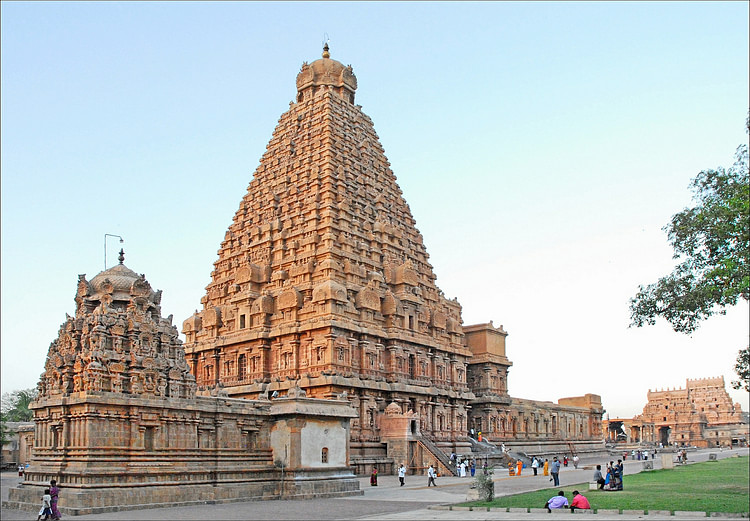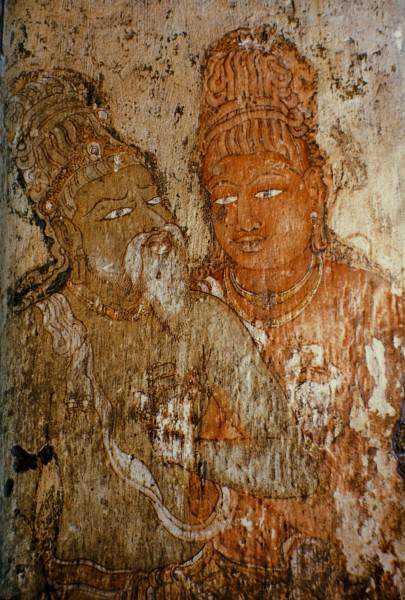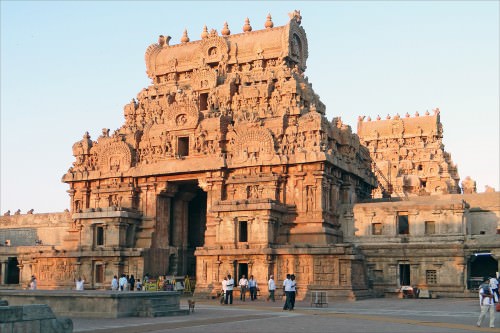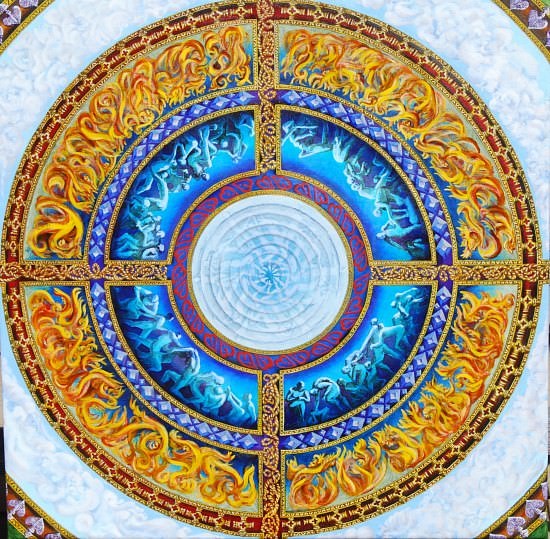Thanjavur › Charvaka » Ancient origins
Articles and Definitions › Contents
- Thanjavur › Antique Origins
- Charvaka › Antique Origins
Ancient civilizations › Historical and archaeological sites
Thanjavur › Antique Origins
Definition and Origins

Thanjavur ( Tanjavur or Tanjore) is a temple site in the Tamil Nadu region of southern India. Thanjavur was the capital of the great Chola (Cola) king Rajaraja I, and it was he who commissioned the site's magnificent temple, the Brihadishvara, in the early 11th century CE. Many other temples and shrines were added over the centuries making Thanjavur one of the most important and most visited historical sites in India today.
THE BRIHADISHVARA TEMPLE
Also known as the Rajarajeshvara, after the king who built it, the Brihadishvara (or Brhadisvara) temple was constructed between c. 995 and 1025 CE using Chola war booty and tribute from Sri Lanka. The temple was dedicated to the Hindu god Shiva. Reaching a height of 63 metres, it is the tallest temple building in India. The entire rectangular complex measures approximately 140 x 75 metres and is surrounded by a wall with regular interior niches. Inside the compound are various secondary shrines and a monumental double gateway entrance ( gopuras ).
REACHING A HEIGHT OF 63 METRES THE BRIHADISHVARA IS THE TALLEST TEMPLE IN INDIA.
The two-storey Brihadishvara temple is built on a high dadoed-base platform. The granite tower ( vimana ), which rises in thirteen diminishing levels above the sacred garbhagriha (inner shrine), is topped by a dome structure which rests on a single 7.7 m square granite block weighing around 80 tons. The building has a front entrance porch ( mandapa ) with 36 columns, and there are two additional entrances at the base of the tower on each side. All three entrances are decorated with guardian figure sculptures, some double life-size, and are approached by a richly carved monumental flight of stairs. The hundreds of niches of the exterior are decorated with sculpture of divine figures ( murti ) – especially Shiva and Devi, lion heads ( kirttimukha ), and fan shapes.
The temple was laid out on a precise plan of 16 x 16 squares, a design known as padmagarbhamandala in the Dravida architecture of southern India. The interior contains the typical passageway for worshippers to perform a circumambulation, in this case on two levels. The garbhagriha contains a 4-metre tall Shiva linga (phallus). There is a snapana platform, too, for the ritual bathing of the god located within a portico (ardhamandapa). Murals decorate the interior walls, and, once hidden by later Nayaka period paintings, these include fine images of Rajaraja I, his spiritual advisor or guru, and his three queens. Other subjects include a Nataraja (Shiva as Lord of the Dance) who was the clan deity of the Cholas ( kuladevata ).

Rajaraja I Mural, Tanjavur
Rararaja I (r. 985-1014 CE) and his son Rajendra I (r. 1012-1044 CE) both filled the temple with bronze sculpture, including images of the kings and their queens, upon which were hung precious jewellery. As indicated in inscriptions, the Cholas also paid for regular offerings of incense, food, and flowers and ensured that the temple was well-maintained by attendants and no fewer than 400 dancing girls – an increasingly important aspect of Hindu worship from that time onwards. Funds were also acquired by partitioning off the surrounding land which would be controlled by priests and the income used to upkeep the temple. Indeed, a whole community arose at the site and included accountants, merchants, and administrators, creating a model which would be copied at other Indian temple sites thereafter.

Monumental Gateway, Brihadishvara Temple, Tanjavur
THE GOPURAS
The gopuras at Thanjavur are two huge monumental gateways which lead to the compound dominated by the Brihadishvara temple. They are the earliest mature examples of the form in southern India. Built on the eastern side of the complex, the outer gopura has five stories and the inner one three. Each gopura has a centrally positioned entrance giving access to a single two-storied chamber on each side of it. The gopuras at Thanjavur are unique because each façade (interior and exterior) is not identical as in later examples. The outer facades each have two large dvarapalas (door guardians) as well as figure sculpture in their many niches and large decorative fan shapes. The top of each gopura is crowned with a massive shala or barrel-vaulted roof. Eventually at other sites gopuras would become even larger and more spectacular than the temples themselves.
Other buildings in the compound include the Nandi mandapa portico, located directly between the gopuras and the Brihadishvara temple. A later addition to the site located at the opposite end to the gopuras is the Subrahmanya Shrine, built in c. 1750 CE.
MAP
Charvaka › Antique Origins
Definition and Origins

The Charvaka school was a philosophical movement in India that rejected the traditional religious order by challenging the authority of the Vedas as well as the hegemony the Brahman priests. Contrary to the view that India has always been an entirely religious and spiritual land, the Charvaka school is one of the most irreligious and skeptical systems of thought ever devised. This school is considered part of the heterodox systems (also referred to as heresies) of Indian philosophy, and it is also known as Lokayata, a term which in Sanskrit and Pali means “Naturalist” or “Worldly”.
ORIGIN & EARLY DEVELOPMENT
The Charvaka school started to develop around the 7th century BCE, during the time when the culture of world renunciation emerged in India. Buddhist scriptures occasionally mention the Charvaka as part of the wandering religious groups known as sramanas. Before the time of the Charvaka school, there were other materialistic schools in India, but none of them managed to systematize their teachings like the Charvaka did.
THE CHARVAKA SCHOOL CHALLENGED THE TRADITIONAL RELIGIOUS ORDER IN INDIA, ENCOURAGING A SORT OF SPIRITUAL VACUUM THAT COMPELLED THE DEVELOPMENT OF NEW RELIGIOUS ALTERNATIVES.
The founder of the Charvaka school is considered to be Brihaspati, who seems to be more of a legendary figure rather than an actual person. The most prominent member of this school during the time of the Buddha was a man named Ajita Kesakambali (Ajita of the Hair Blanket), whose ideas are summarized in a Buddhist Pali text known as Samannaphala Sutta, where he denies the doctrine of transmigration of the soul.
CHARVAKA DOCTRINE & CORE BELIEFS
The earliest texts of the Charvaka were written around the 6th century BCE, but unfortunately, they have been lost. From what we can piece together, mainly through later works, these thinkers believed in a rigid materialistic perspective in which only things that could be perceived directly were thought to exist. Some of the key principles of this doctrine of materialism were:
- All things are made of earth, air, fire and water.
- That which cannot be perceived does not exist; to exist implies to be perceivable.
- Heaven and hell are nothing but inventions. The only goal of humans is to enjoy pleasures and avoid pain.
- Providing a good living for the priests is a sufficient explanation for the practice of religion.
The members of this school did not believe in ideas such as the soul, reincarnation, spirits, or gods. Religion, they said, is nothing but a fraud devised by clever men who want to take advantage of others. Soul or consciousness can be explained in natural terms as a side effect of having a healthy body: When the body dies, consciousness simply disappears. No existence other than the physical body exists for the Charvaka.
The attitude towards human conduct in the Charvaka school was a very flexible one: Right or wrong were seen as merely human conventions. The cosmos, they believed, was indifferent to human behaviour. If this life is all there is, if there is no afterlife whatsoever, then we should live enjoying the physical life the best we can.
There were a number of aphorisms ascribed to Brihaspati that have also been lost. Only a brief poem used to denounce the priestly caste has survived to our days:
The costly rites enjoined for those who dieAre but a means of livelihood devisedBy sacerdotal cunning, nothing more....While life endures let life be spent in easeAnd merriment; let a man borrow moneyFrom all his friends, and feast on melted butter(Durant, 418)
This poem is particularly provocative if we keep in mind that butter was poured into the sacrificial fire by the Brahman priests.
In the novel about the life of the Buddha named "A Spoke in the Wheel", the author paraphrases some of the criticisms of the Charvaka school concerning the practices of Brahman priests. Although this is only fiction, it reflects some good points of conflict between the Charvaka and the traditional religious order:
[...] Spells, incantations, rituals, even the duties of the four varnas [castes] - all these are nonsense, invented for the livelihood of those destitute of knowledge and manliness. If a beast slain in the Jvotistoma rite [Vedic ritual] goes straight to heaven, why doesn't the sacrificer offer his father instead? If offerings to priests can feed ancestors in heaven, how is it that that person standing on top of a house cannot be gratified by food served inside? They cannot - because all such long-distance gratification is buffoonery!(Kanekar, 181)
The materialism that the Charvaka school advocated in India was popular for quite a long time. It claimed that the truth can never be known except through the senses: The body, not the soul, feels, sees, hears and thinks. Religions flourish only because people have become accustomed to them. Faith is destroyed by true knowledge and when this happens, people feel a sense of loss and an uncomfortable void that's difficult to handle. Nature is indifferent to human conventions, such as good and bad or even virtue and vice. The sun shines equally upon sinners and saints.
The Charvaka school challenged the traditional religious order in India, weakening the authority and reputation of the priests and encouraging a sort of spiritual vacuum in Indian society that compelled the development of new religious alternatives. The materialistic ideas were so strong that the new religions, which arose to replace the old faith, were devotions without a god or gods or, in other words, non-theistic religions. Such an idea might sound like a contradiction in itself, but that was exactly the approach of some of the main religious movements that appeared as a result of this religious controversy. In a reaction against the priestly class, these new religions originated in the Kshatriyas caste (the warrior rulers caste), opposing the traditional priestly hegemony. In this context of religious crisis, Jainism and Buddhism were born.
LICENSE:
Article based on information obtained from these sources:with permission from the Website Ancient History Encyclopedia
Content is available under License Creative Commons: Attribution-NonCommercial-ShareAlike 3.0 Unported. CC-BY-NC-SA License